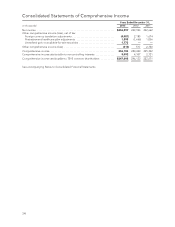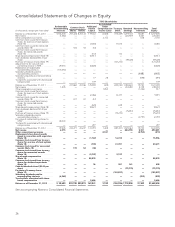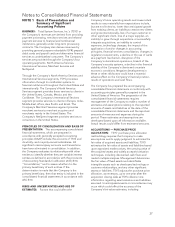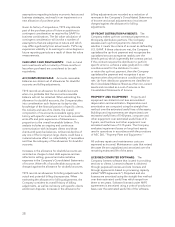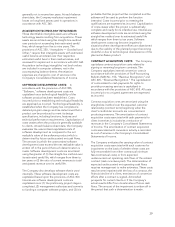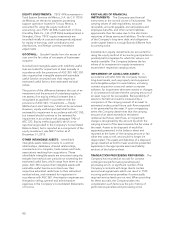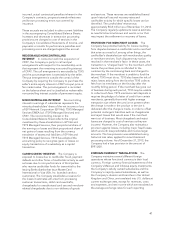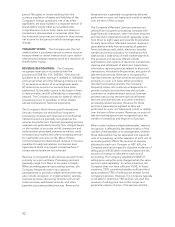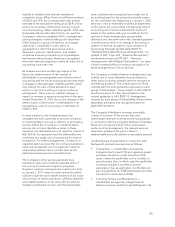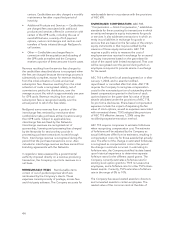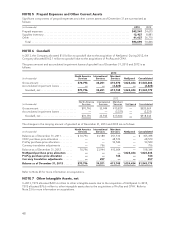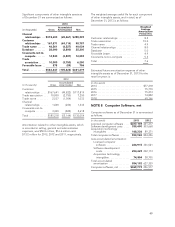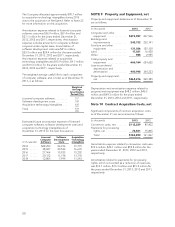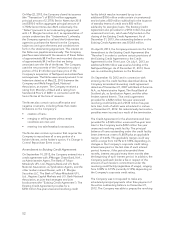NetSpend 2013 Annual Report Download - page 45
Download and view the complete annual report
Please find page 45 of the 2013 NetSpend annual report below. You can navigate through the pages in the report by either clicking on the pages listed below, or by using the keyword search tool below to find specific information within the annual report.inability to reliably verify relevant standalone
competitor prices. When there is insufficient evidence
of VSOE and TPE, the Company has made its best
estimate of the standalone selling price (ESP) of that
service for purposes of allocating revenue to each
unit of accounting. When determining ESP, TSYS uses
limited standalone sales data that do not meet the
Company’s criteria to establish VSOE, management
pricing strategies, residual selling price data when
VSOE exists for a group of elements, and margin
objectives. Consideration is also given to
geographies in which the services are sold or
delivered, customer classifications, and market
conditions including competitor pricing strategies
and benchmarking studies. Revenue is recognized
when the revenue recognition criteria for each unit of
accounting have been met.
As business and service offerings change in the
future, the determination of the number of
deliverables in an arrangement and related units of
accounting and the future pricing practices may result
in changes in the estimates of VSOE and ESP, which
may change the ratio of fees allocated to each
service or unit of accounting in a given customer
arrangement. There were no material changes or
impact to revenue in revenue recognition in the year
ended December 31, 2013 due to any changes in the
determination of the number of deliverables in an
arrangement, units of accounting, or estimates of
VSOE or ESP.
In many situations, the Company enters into
arrangements with customers to provide conversion
or implementation services in addition to processing
services where the conversion or implementation
services do not have standalone value. In these
situations, the deliverables do not meet the criteria of
ASC 605-25 for separation and the deliverables are
combined as a single unit of accounting for revenue
recognition. For these arrangements, conversion or
implementation services that do not have standalone
value, are recognized over the expected customer
relationship (contract term) contract term as the
related processing services are performed.
The Company’s other services generally have
standalone value and constitute separate units of
accounting for revenue recognition purposes.
However, customer arrangements entered into prior
to January 1, 2011 often included services for which
sufficient objective and reliable evidence of fair value
did not exist. In certain situations, sufficient objective
and reliable evidence of fair value did not exist for
multiple undelivered services, and the deliverables
were combined and recognized as a single unit of
accounting based on the proportional performance
for the combined unit. Beginning on January 1, 2011,
services in new or materially modified arrangements
of this nature are now divided into separate units of
accounting and revenue is allocated to each unit
based on the relative selling price method. As the
services in these arrangements are generally
delivered over the same term with consistent patterns
of performance, there is no change in the timing or
pattern of revenue recognition upon adoption of
Accounting Standard Update (ASU) 2009-13,
“Multiple-Deliverable Revenue Arrangements,” an
update to ASC Topic 605, “Revenue Recognition,”
and formerly known as EITF 08-1, “Revenue
Arrangements with Multiple Deliverables”, nor does
it have a material effect on revenue recognition for
these arrangements in future periods.
The Company’s multiple element arrangements may
include one or more elements that are subject to
other topics including software revenue recognition
and leasing guidance. The consideration for these
multiple element arrangements is allocated to each
group of deliverables – those subject to ASC 605-25
and those subject to other topics based on the
revised guidance in ASU 2009-13. Arrangement
revenue for each group of deliverables is then further
separated, allocated, and recognized based on
applicable guidance.
The Company’s NetSpend revenues principally
consist of a portion of the service fees and
interchange revenues received by the Issuing Banks
in connection with the programs NetSpend manages.
Revenue is recognized when there is persuasive
evidence of an arrangement, the relevant services
have been rendered, the price is fixed or
determinable and collectability is reasonably assured.
Cardholders are charged fees in connection with
NetSpend’s products and services as follows:
• Transactions — Cardholders are typically
charged a fee for each PIN and signature-based
purchase transaction made using their GPR
cards, unless the cardholder is on a monthly or
annual service plan, in which case the cardholder
is instead charged a monthly or annual
subscription fee, as applicable. Cardholders are
also charged fees for ATM withdrawals and other
transactions conducted at ATMs.
• Customer Service and Maintenance —
Cardholders are typically charged fees for
balance inquiries made through NetSpend’s call
43



